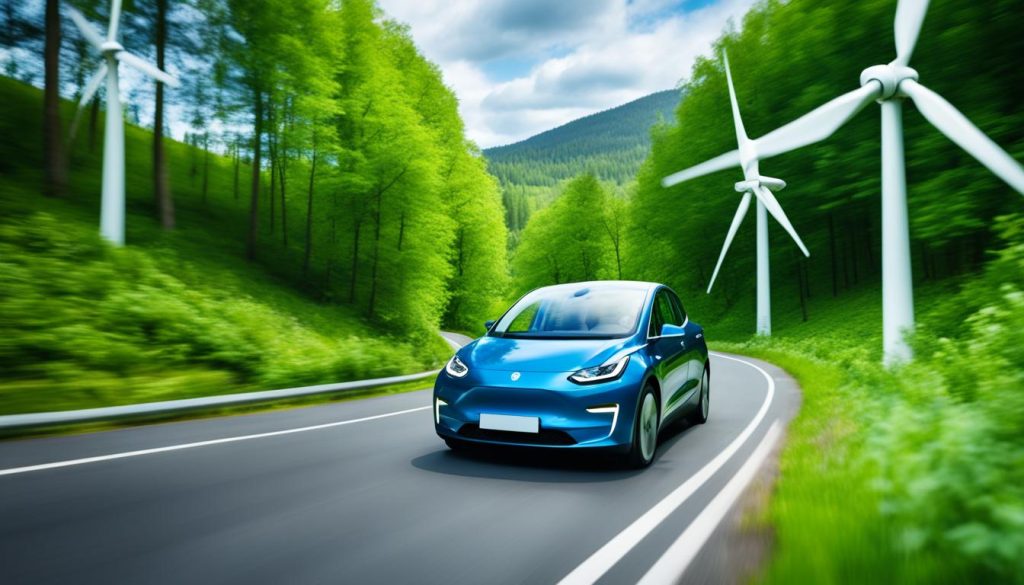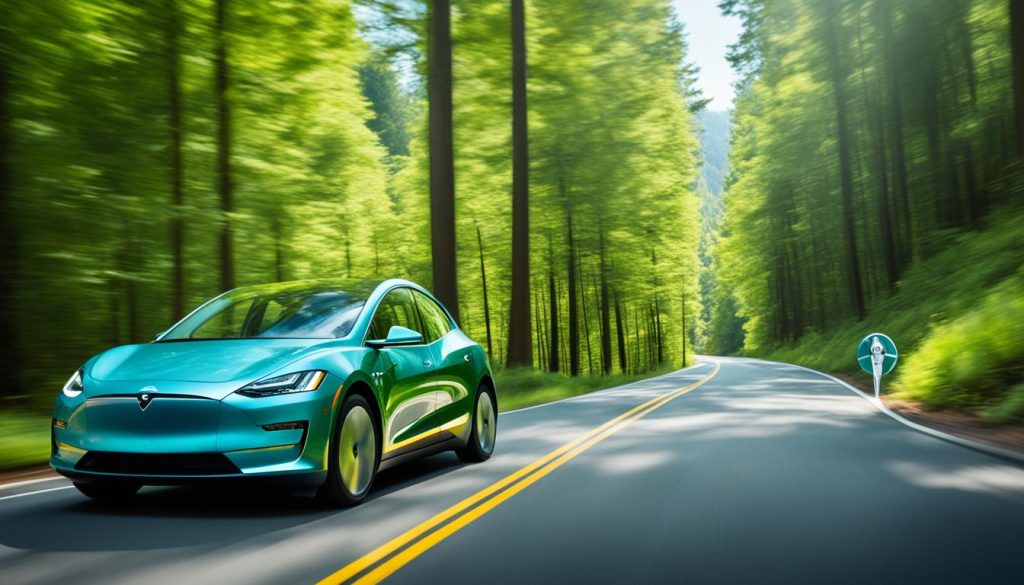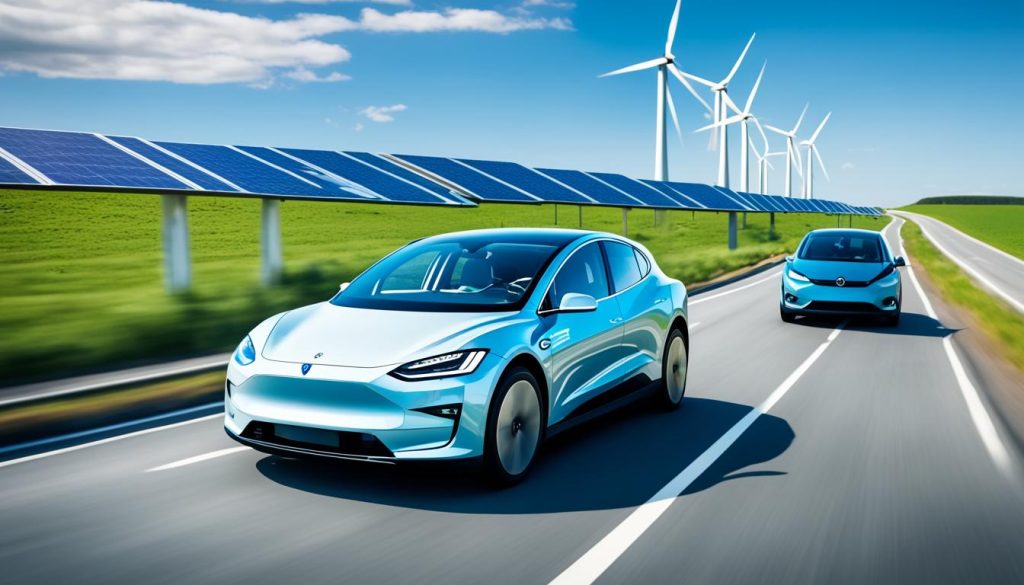Welcome to our exclusive series on electric motoring and eco-friendly driving. In this section, we take a closer look at the world of electric vehicles and provide you with valuable insights and tips for a smarter and greener way of travel.
As the world shifts towards sustainable transportation options, electric motoring has emerged as a key player in reducing carbon emissions and fostering a cleaner environment. Electric cars offer numerous benefits that go beyond just saving money on fuel costs. They provide a more eco-friendly driving experience, better performance, and a glimpse into the future of transportation.
Throughout this series, we will explore the many advantages of electric cars, including their positive impact on the environment, cost savings, and improved driving experience. We will also share practical tips on maximizing electric car efficiency, addressing concerns about charging infrastructure and range anxiety, and adopting green driving habits for a sustainable future.
Furthermore, we will dive into the evolution of electric vehicles, highlighting their history, significant milestones, and future trends. We will also discuss the various incentives and government support available for electric vehicle owners, making the switch to electric driving more accessible and affordable for everyone.
So get ready to join us on this electrifying journey as we unravel the world of electric motoring and explore its potential to revolutionize the way we drive. Together, we can make a difference and contribute to a greener, cleaner, and more sustainable future.
Exploring the Benefits of Electric Cars
When it comes to greener transportation choices, electric cars are leading the way. Not only do they offer a solution to reducing carbon emissions, but they also provide numerous benefits that appeal to eco-conscious drivers. In this section, we will explore the wide range of advantages that electric cars bring to the table, making them an excellent choice for individuals looking to make a positive impact on the environment.
Positive Impact on the Environment
One of the most significant benefits of electric cars is their positive impact on the environment. Unlike traditional internal combustion engine vehicles that rely on fossil fuels, electric cars run on electricity, resulting in zero tailpipe emissions. By driving an electric car, you can help reduce air pollution, greenhouse gas emissions, and dependence on fossil fuels, thereby contributing to a cleaner, healthier planet for future generations.
Cost Savings
Switching to an electric car can also lead to significant cost savings in the long run. Although the initial purchase price of an electric car may be higher than that of a traditional vehicle, you can potentially save money on fuel and maintenance expenses. Electricity is generally cheaper than gasoline, and charging your electric car at home can cost less than refueling at a gas station. Additionally, electric cars have fewer moving parts, which can result in lower maintenance and repair costs over time.
Performance Benefits
Contrary to common misconceptions, electric cars offer impressive performance benefits. Electric motors provide instant torque, delivering quick acceleration and smooth, responsive driving experiences. With no gears to shift, electric cars offer seamless acceleration and a quieter ride. Additionally, electric cars often have a low center of gravity due to their battery placement, enhancing stability and improving handling on the road.
Overall, the benefits of electric cars extend beyond environmental considerations. From cost savings to improved performance, electric cars offer a compelling package for those seeking a greener and more sustainable mode of transportation.
| Benefits of Electric Cars | Description |
|---|---|
| Positive Impact on the Environment | Electric cars produce zero tailpipe emissions, reducing air pollution and greenhouse gas emissions. |
| Cost Savings | Electric cars can lead to long-term savings on fuel and maintenance expenses. |
| Performance Benefits | Electric cars offer instant torque, quick acceleration, and a smooth, responsive driving experience. |
Tips for Maximizing Electric Car Efficiency
When it comes to electric cars, maximizing efficiency is key. By implementing a few simple strategies, you can extend the battery life of your electric vehicle and enhance its overall performance. Let’s explore some tips to help you get the most out of your eco-friendly ride:
1. Understand Battery Management
The battery is the heart of your electric car, so it’s crucial to understand how to manage it effectively. Avoid letting the battery charge drop too low, as this can impact its longevity. On the other hand, try not to keep it fully charged for extended periods, as excessive charging can also cause wear. Aim to maintain a charge level between 20% and 80% to maximize battery life.
2. Optimize Regenerative Braking
Take advantage of regenerative braking, a feature available in most electric cars. This technology recaptures some of the energy lost during braking and converts it back into electricity to recharge the battery. By driving in a more anticipatory manner and using regenerative braking, you can minimize energy waste and increase the efficiency of your electric car.

3. Embrace Eco-Friendly Driving Techniques
Developing eco-friendly driving habits can significantly improve the efficiency of your electric car. Maintain a steady speed, avoid rapid acceleration and heavy braking, and anticipate traffic conditions to reduce energy consumption. Additionally, use your car’s eco-mode or energy-saving features, such as limiting HVAC usage and reducing auxiliary power usage, to optimize efficiency.
4. Plan Efficient Routes
Planning your routes strategically can help maximize your electric car’s efficiency. Look for charging stations along your journey to ensure you have convenient options for recharging when needed. Consider utilizing smartphone apps or in-car navigation systems that factor in charging station locations and provide real-time updates to help you plan the most efficient route.
5. Regularly Maintain Your Electric Car
Proper maintenance is vital for keeping your electric car running efficiently. Regularly schedule check-ups with a qualified technician to ensure that your vehicle’s components, including the battery, cooling system, and tires, are in optimal condition. Maintaining proper tire pressure, for example, can minimize energy consumption and improve your electric car’s overall efficiency.
By applying these practical tips, you can maximize the efficiency of your electric car and contribute to a greener future of transportation.
Charging Infrastructure and Range Anxiety
One of the common concerns potential electric car owners have is the accessibility of charging infrastructure and the fear of range anxiety. However, it’s important to note that as the popularity of electric vehicles continues to grow, so does the charging infrastructure network.
Today, there are numerous charging stations available, ranging from public charging stations located at shopping centers, office buildings, and parking lots, to home charging options. This expanding network ensures that electric car owners have convenient access to charging facilities, making it easier than ever to keep their vehicles powered up.
Advancements in charging technology have also helped alleviate range anxiety. Fast-charging options, such as Tesla’s Supercharging network, allow electric car owners to quickly recharge their vehicles, providing peace of mind during long journeys. Additionally, modern electric cars are equipped with larger battery capacities, leading to longer driving ranges. For instance, the Tesla Model S offers a range of up to 370 miles on a single charge, significantly reducing concerns about running out of power.
Overcoming range anxiety is not only a technological feat but also involves a shift in mindset. Being aware of your driving habits and planning your trips accordingly can help minimize range anxiety. There are now smartphone apps and in-car navigation systems that provide real-time information about nearby charging stations and their availability.
“Range anxiety is slowly becoming a thing of the past, thanks to the continuous expansion of charging infrastructure and the introduction of advanced electric vehicle models with longer driving ranges.”
Benefits of an Expanding Charging Infrastructure
The availability of a robust charging infrastructure offers several benefits to electric car owners and the wider community:
- Convenience: With an extensive charging network, recharging your electric car becomes as easy as refueling a conventional vehicle.
- Flexibility: Public charging stations enable drivers to top up their vehicles while running errands or during longer road trips.
- Sustainability: Widespread charging infrastructure promotes the adoption of electric vehicles, reducing greenhouse gas emissions and contributing to a cleaner and greener environment.
- Cost Savings: Charging at home or using public stations can be more cost-effective compared to traditional fueling options.
As the electric vehicle market continues to grow, the charging infrastructure network will expand further, making electric motoring a convenient and stress-free experience for all drivers.
Current State of Charging Infrastructure
Let’s take a closer look at the current state of charging infrastructure in some regions:
| Region | Number of Charging Stations | Fast Charging Stations Available |
|---|---|---|
| United States | Over 100,000 | Approximately 10,000 |
| Europe | Over 200,000 | Approximately 30,000 |
| China | Over 500,000 | Approximately 150,000 |
These figures demonstrate the significant investment in charging infrastructure across different regions, ensuring the accessibility of charging facilities for electric vehicle owners.
Overcoming Range Anxiety
To overcome range anxiety, consider the following tips:
- Plan your trips: Before embarking on a long journey, identify charging stations along your route and plan your stops accordingly.
- Take advantage of fast-charging options: Utilize the growing network of fast-charging stations to minimize charging time during extended trips.
- Use smartphone apps and navigation systems: Stay informed about nearby charging stations and their availability using dedicated apps or in-car navigation systems.
- Consider home charging: Install a home charging station to conveniently charge your electric vehicle overnight, ensuring it is ready for use the next day.
By adopting these strategies, you can confidently navigate the charging network, overcome range anxiety, and enjoy the benefits of electric motoring.
With an expanding charging infrastructure, advancements in technology, and effective range management, electric motoring is becoming a stress-free and convenient choice for drivers worldwide.
Green Driving Habits for a Sustainable Future
As we strive for a sustainable future, adopting green driving habits becomes crucial in minimizing our carbon footprint and protecting the environment. By implementing eco-friendly practices and embracing innovative technologies, we can contribute to a cleaner and healthier world for future generations.
Regenerative Braking: Harnessing Energy for Efficiency
One of the key techniques in green driving is regenerative braking, a technology that converts kinetic energy into electric energy. When you apply the brakes, the system captures the energy that would have been wasted as heat and transfers it back to the vehicle’s battery. This process enhances the efficiency of electric vehicles (EVs) and helps to extend their range.
“Regenerative braking not only improves the overall efficiency of electric vehicles but also reduces wear and tear on traditional braking systems, resulting in lower maintenance costs.” – Sarah Johnson, EV Enthusiast
To make the most of regenerative braking, it’s important to anticipate traffic flow and try to avoid sudden acceleration or braking. By maintaining a steady pace and allowing the regenerative braking system to do its job, you can maximize energy recapture and increase your EV’s efficiency.
Intelligent Route Planning: Optimize Your Journey
Intelligent route planning is another green driving habit that can significantly reduce emissions and optimize your journey. Utilizing navigation systems or mobile apps specifically designed for EVs, you can plan routes that prioritize charging stations along the way. By considering factors such as traffic congestion, elevation changes, and weather conditions, these tools can help you find the most energy-efficient and eco-friendly path.
In addition to avoiding unnecessary detours, intelligent route planning allows for better management of charging stops. By strategically planning your charging breaks, you can minimize charging time and ensure a smooth and uninterrupted journey.
Minimize Energy Consumption: Simple Actions, Big Impact
Adopting a few simple habits can go a long way in minimizing energy consumption and promoting greener driving. Some of these practices include:
- Avoiding excessive idling: Turn off the engine whenever possible to conserve energy and reduce emissions.
- Reducing unnecessary weight: Remove any unnecessary items from your vehicle to decrease energy demands and improve fuel efficiency.
- Driving at a moderate speed: Maintaining a steady and moderate speed ensures optimal fuel efficiency and reduces the strain on the vehicle’s battery.
- Using eco-mode settings: Many EVs offer eco-mode settings that adjust various vehicle systems to maximize energy efficiency.

Driving Towards a Sustainable Future
By adopting green driving habits, we not only reduce our carbon footprint but also inspire positive change in others. As more drivers embrace eco-friendly practices, the demand for sustainable transportation solutions will increase. This, in turn, will accelerate the transition towards a cleaner, greener future.
| Benefits of Green Driving Habits | Actions for a Sustainable Future |
|---|---|
| – Lower carbon emissions | – Promote public transportation |
| – Reduced fuel consumption | – Support EV charging infrastructure development |
| – Improved air quality | – Advocate for sustainable urban planning |
| – Lower maintenance costs | – Educate others about eco-friendly driving habits |
The Evolution of Electric Vehicles
Electric vehicles have come a long way since their early beginnings, undergoing a remarkable evolution to become the advanced technology we know today. From their humble origins to the current state of the electric motoring industry, let’s explore the significant milestones, breakthroughs, and future developments…
The Birth of Electric Cars
The roots of electric vehicles can be traced back to the early 19th century when inventors like Thomas Davenport and Robert Anderson pioneered the concept of electric propulsion. These early electric cars relied on bulky batteries and limited range, but they laid the foundation for the future of electric motoring.
In the late 1800s, electric vehicles gained popularity, especially among affluent city dwellers who appreciated their quiet operation and zero emissions. Brands like Columbia, Riker, and Detroit Electric emerged, producing electric cars that boasted a level of comfort and refinement unmatched by their gasoline-powered counterparts.
Challenges and the Rise of Gasoline Engines
Despite their initial success, electric vehicles faced challenges, such as limited range and lengthy recharging times. Additionally, advancements in the internal combustion engine and the development of mass production techniques by Henry Ford significantly contributed to the rise of gasoline-powered cars.
“It was not until the early 20th century that gasoline-powered cars gained widespread popularity, largely due to their longer range and the availability of fueling infrastructure. As a result, electric cars gradually took a backseat in the automotive industry.” – Automotive Historian
The Revival of Electric Vehicles
The 21st century marked a turning point for electric vehicles, fueled by increasing concerns about climate change, rising fuel costs, and advancements in battery technology. The introduction of the Tesla Roadster in 2008 revolutionized the perception of electric cars, showcasing their potential for performance, range, and style.
Since then, major automakers like Nissan, Chevrolet, and BMW have joined the electric revolution, introducing models such as the Nissan Leaf, Chevrolet Bolt, and BMW i3. These vehicles offer impressive driving ranges, improved charging infrastructure, and innovative features that have captivated an ever-growing number of eco-conscious drivers.
The Rise of Electric Mobility
Beyond passenger cars, electric vehicles have expanded into various segments, including buses, trucks, and even motorcycles. Companies like Proterra, Tesla, and Zero Motorcycles have shown that electric mobility is not limited to traditional modes of transportation. Electric buses are revolutionizing public transportation, while electric trucks offer a sustainable alternative for commercial fleets.
Looking Toward the Future
The evolution of electric vehicles shows no signs of slowing down. Advancements in battery technology and charging infrastructure continue to push the boundaries of what electric cars can achieve. Furthermore, the emergence of autonomous electric vehicles promises to reshape the way we think about transportation, offering a glimpse of a future where sustainable, self-driving vehicles are the norm.
“The evolutionary journey of electric vehicles so far has been remarkable, and the future holds even greater promise. With ongoing innovation and increased support from governments and the industry, we can anticipate an electric motoring landscape that is sustainable, efficient, and exciting.” – Electric Vehicle Enthusiast
Electric Vehicle Incentives and Government Support
As the world transitions to a more sustainable future, governments around the globe are stepping up their efforts to support the adoption of electric vehicles (EVs). In recognition of the environmental benefits and reduced carbon emissions associated with EVs, many governments are offering a range of incentives and financial support to make electric motoring more accessible and affordable for consumers.
One of the most significant incentives provided by governments is in the form of electric vehicle incentives. These incentives can take various forms, such as tax credits, rebates, and reduced registration fees. By implementing these measures, governments aim to encourage consumers to choose electric vehicles over traditional internal combustion engine cars, ultimately reducing pollution and improving air quality.
Additionally, governments also offer a variety of financial support programs to promote the growth of EV infrastructure. These programs include grants and subsidies for the development of charging stations, as well as investments in research and development to drive technological advancements in battery technology and energy storage.
By creating a supportive environment for electric vehicles, governments are not only incentivizing consumers but also actively working towards their own sustainability targets. The increased adoption of EVs plays a crucial role in reducing greenhouse gas emissions and mitigating the impacts of climate change.
The Role of Tax Credits
A significant aspect of government support for electric vehicles is the provision of tax credits. These credits are designed to reduce the cost of purchasing an electric vehicle, making them more affordable for consumers.
Depending on the country and region, tax credits for EVs can range from a fixed amount to a percentage of the vehicle’s purchase price. These tax incentives effectively reduce the sticker price of EVs, making them comparable in cost to conventional gasoline-powered cars.
Furthermore, some governments offer additional incentives for electric vehicle owners, such as reduced toll fees, free parking, and access to high-occupancy vehicle (HOV) lanes, providing further benefits beyond the initial purchase price reduction.
Grants and Subsidies for Charging Infrastructure
Another critical area of government support for electric vehicles is the funding provided for charging infrastructure. Governments worldwide recognize the importance of a robust and accessible network of charging stations to alleviate concerns about range anxiety and facilitate the widespread adoption of EVs.
Through grants and subsidies, governments encourage private entities and organizations to invest in the development of charging stations in public areas, workplaces, and residential complexes. These incentives play a vital role in ensuring that EV owners have convenient and reliable access to charging facilities, whether they are at home, at work, or on the road.
Table: Comparison of Government Support for Electric Vehicles in Select Countries
| Country | Tax Credits | Charging Infrastructure Grants |
|---|---|---|
| United States | $7,500 federal tax credit | Up to 30% of charging station costs |
| Norway | No purchase tax or VAT | Support for nationwide fast-charging network |
| China | Purchase subsidies up to $7,000 | Financial support for charging infrastructure |
| Germany | Up to €9,000 in purchase incentives | Grants for charging infrastructure in public spaces |
Table: Comparison of Government Support for Electric Vehicles in Select Countries
It is evident that governments worldwide are taking a proactive approach to support the widespread adoption of electric vehicles. Through a combination of tax credits, grants, and subsidies, governments are incentivizing consumers and private entities to embrace electric motoring, contributing to a cleaner and greener future for all.
The Future of Electric Motoring
As we look ahead, the future of electric motoring holds tremendous promise. Advancements in battery technology are revolutionizing the industry, offering longer ranges and faster charging times. This means that electric vehicles (EVs) will become even more accessible and convenient, with the ability to travel farther and charge up in a fraction of the time. The future will undoubtedly bring even more efficient and powerful batteries, making electric motoring a compelling option for all.
Another exciting trend to watch out for is the rise of autonomous electric vehicles. Self-driving cars are already becoming a reality, and when combined with electric powertrains, they have the potential to revolutionize mobility. Imagine a future where you can simply hop into an electric car, relax, and let the vehicle take you to your destination while minimizing traffic congestion and carbon emissions.
Moreover, the electric motoring industry is driving innovative solutions in transportation, pushing the boundaries of technology and sustainability. From lightweight materials to regenerative braking systems, every aspect of electric vehicles is being optimized to create cleaner, more efficient modes of transportation. With electric motoring at the forefront of these developments, we can expect a future where eco-friendly driving becomes the standard.
As consumer demand for electric vehicles continues to rise, governments and car manufacturers are investing heavily in research and development. In response, we will witness the expansion of charging infrastructure, with more charging stations readily available in urban areas and along major highways. This infrastructure growth will provide peace of mind to EV owners, eliminating any range anxiety concerns and further boosting the future of electric motoring.



